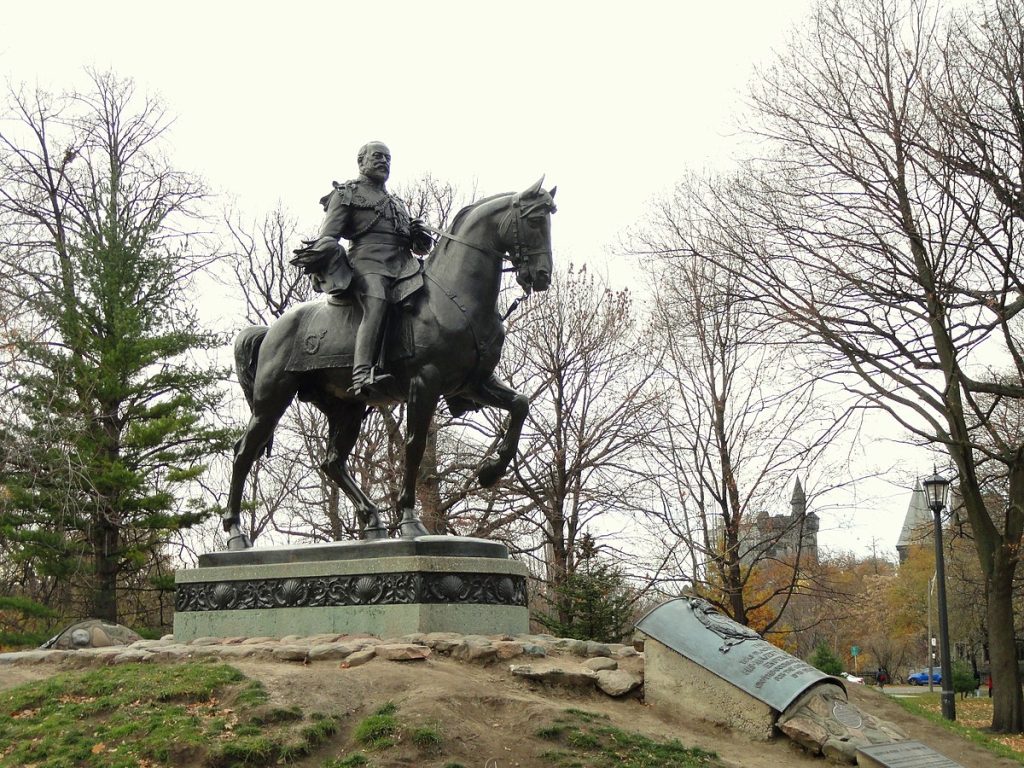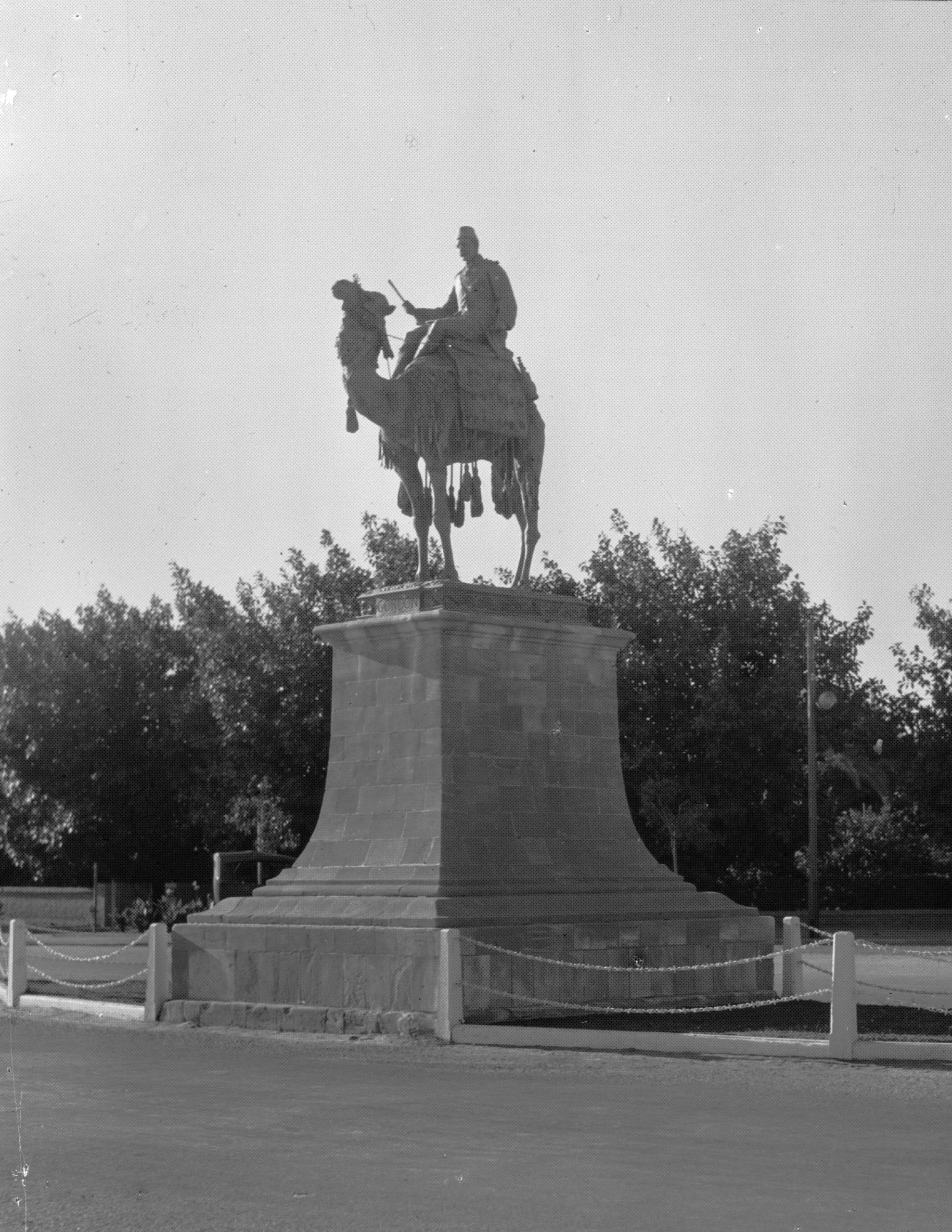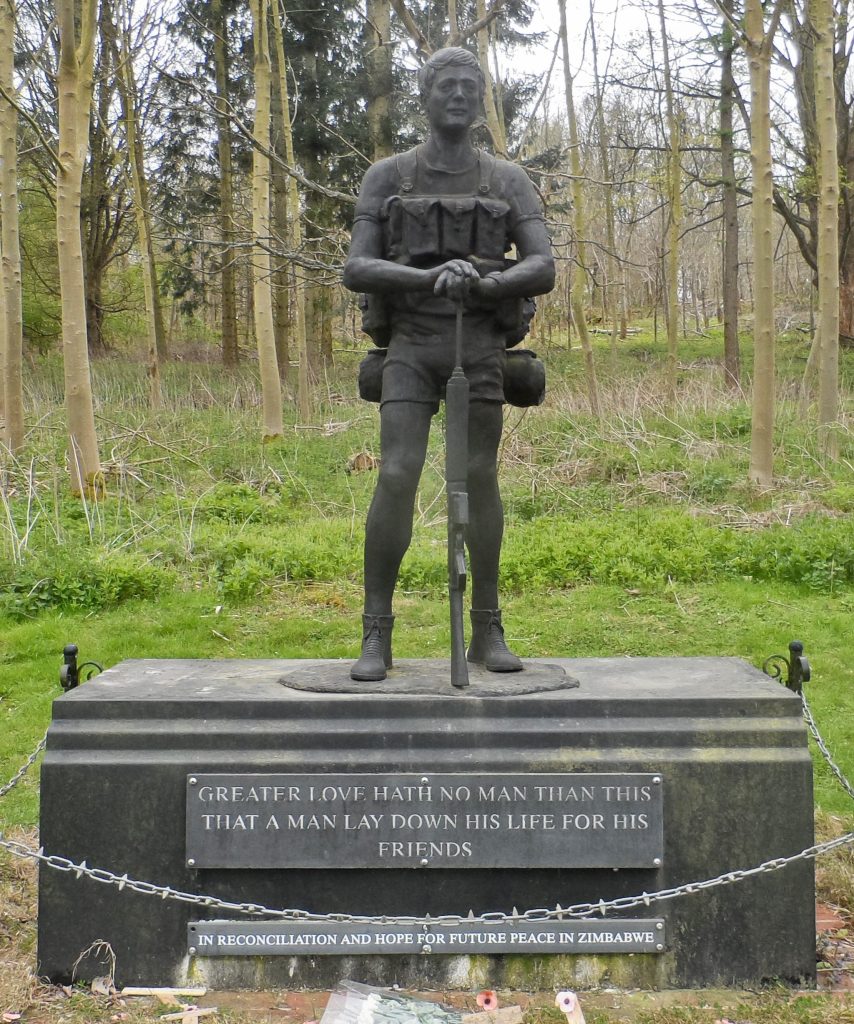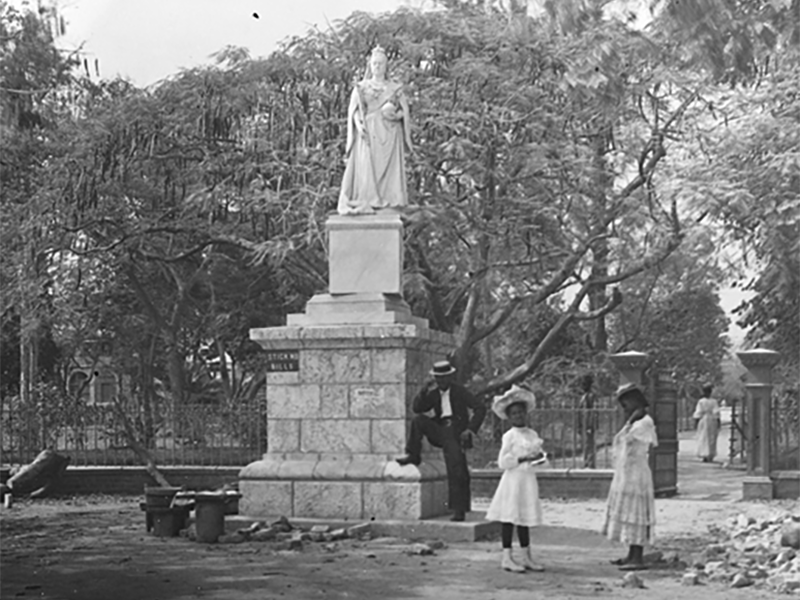
Image credit: Wikimedia / York Museums Trust.
Restitution and repatriation of objects looted (from the Hindi lūṭ, or ‘to rob’) by European imperial powers has been a key aim of decolonisation campaigns across the planet, with the focus on pressuring European countries like Britain and France to return stolen colonial items to their home countries. Tracing the afterlives of colonial statues, however, reveals a different and little-known history of repatriation: that of colonial statues themselves. This blog post is about the history of Britain’s attempts to recover and repatriate statues from its former colonies as imperial rule began to crumble.
In the nineteenth and twentieth centuries, a number of statues made in the metropole were exported to British colonies as a form of symbolic power, aimed at celebrating illustrious royal and military figures, whilst also instilling themselves in colonial subjects’ minds as a haunting warning of the cost of resisting imperial “pacification”. During the struggle for decolonisation in the mid-twentieth century, however, many of these statues became increasingly contested by anti-colonial activists across the planet. What Frantz Fanon called un ‘Monde compartimenté, manichéiste, immobile, monde de statue’ (‘a world compartmentalised, Manichean, immobile, a world of statues’ – my italics), words written in the heat of battle in Algeria, was now being challenged by a planetary movement fighting for material and symbolic freedom from Europe.
This blog post sketches out Britain’s response to these developments and the afterlives of four repatriated statues: the Edward VII statue in Toronto, Canada; the Herbert Kitchener statue in Chatham, Kent; the Charles Gordon statue at Gordon’s School, Surrey; and “The Trooper” statue in the grounds of Hatfield House, Hertfordshire. All four of these statues were recovered in a haphazard (and, in the case of the latter, discreet) manner, in light of the absence of any defined or systematic imperial policy for statue repatriation in Britain. An examination of their histories reveals the relationship of colonial statues to imperial networks and geographies, as well as the ways in which statues reconfigure imperial memory in new spaces and points of time.
I. “A Once-Happy Family”: The Colonial Statues Left Behind

Image credit: Wikimedia
Of course, most colonial statues never returned to the metropole at the end of empire. Imperial ruins and debris are scattered across Britain’s former colonies, from India to Australia and from Canada to the Caribbean. If Anne McClintock has described the imperial project as one of “domesticating” colonial subjects and creating the imperial family across the planet (with, of course, a clearly defined matriarch or patriarch), then these left-behind statues are a reminder of the historical and cultural affiliations that were severed in the process of decolonisation.
In India, the regnal statues left behind depicting Queen Victoria and King Edward VII, who once laid claim to the titles of Empress and Emperor of India, are an excellent example of this history. British sculptors exported upwards of twenty royal statues to India to commemorate Victoria and Edward’s reign, and The Yale Center for British Art has mapped several of the monuments to Victoria that were sent to the subcontinent. Mary Ann Steggles estimates that, in total, over 170 portrait statues were exported from Britain to India between 1792 and 1927. Many of these statues have either ended up in Coronation Park, Delhi – the graveyard of British rule in India – or have been placed into museum storage.
Two interesting questions can be raised from these melancholy statues that never made it back to Britain. First is the question of statue “twins” or doppelgangers: which statues in the UK are originals or duplicates of statues “out there” in the postcolony, and where do their histories converge and diverge? In Reading, for example, there is a 1902 statue of Edward VII by George Edward White, which is a double of a second statue produced by White for Chennai in India. Both statues share the same origins but divergent trajectories: the former still stands in Reading’s town centre, while latter has quietly retired to the Government Museum in Chennai.
The second question is this: if the statues didn’t return to the UK, where else in Empire did they go? Another fruitful example is provided by the equestrian statue of King Edward VII, created by the English sculptor Thomas Brock, which lies in Queen’s Park, Toronto. According to Anukriti Gupta, this statue of Edward VII (then known as the “All-India King Edward Memorial”) in Delhi had originally been placed in Coronation Park after Indian independence, but later ended-up being bought by a Canadian businessman and re-erected in Toronto in 1969. The statue, still in place in Toronto today, was targeted during Black Lives Matter in June 2020, with the words “Aboriginal Lives Matter”, “ACAB”, and “Regis was pushed” (referring to the death of Regis Korchinski-Paquet, an Indigenous-Ukrainian-Black Canadian woman) graffitied around the memorial. This particular statue powerfully exemplifies the complex intimacies created by the British Empire, by not only travelling from England, to India, and finally to Canada, but also demonstrating the ways in which memories of empire can be rearticulated in new historical and geographical contexts – in this case, the experience of Indigenous and Black women in twenty-first century Canada.
II. “Militarised Masculinities”: The Kitchener and Gordon Statues

Image credit: Wikimedia
My first blog post for Cast in Stone on colonial statues, public space and masculinity in postcolonial Britain briefly sketched out the long history of the Herbert Kitchener statue in Chatham, Kent, and its travels from India, to Sudan, and then finally back to the UK. New details about history of the Kitchener statue, however, have since come to my attention, and in particular its close relationship to the statue of Charles Gordon at Gordon’s School. The Gordon and Kitchener statues provide a clear example of Britain’s efforts to repatriate colonial statues during the end of empire.
The statue of Gordon and his camel by Edward Onslow Ford was first erected in Khartoum in Sudan by Britain in 1903, with the statue being a second casting of another Gordon statue made in 1890 for Brompton Barracks in Chatham. In 1920, the statue of Gordon was joined by Sidney March’s statue of Herbert Kitchener after it was relocated from Kolkata, India.
In October 1954, Britain and Sudan signed a treaty to grant Sudan independence from colonial rule, beginning on January 1st 1956. This placed the statues of Gordon and Kitchener in an uncomfortable position, and they were removed from public display and put into storage. It is unclear if there were negotiations between the British and Sudanese governments over the statues in this period, but on December 17th 1958 John Profumo announced in Parliament that:
“ Her Majesty’s Government have accepted the offer of the Sudan Government to present the statues of General Gordon and Lord Kitchener to them and the statues will be brought to the United Kingdom in due course. Where they will eventually be placed is being considered” (Hansard)
It was later decided that the statue of Gordon would go to Gordon Boys’ School in Surrey, while the statue of Kitchener would be placed at the School of Military Engineering in Chatham (near to the first statue of Gordon in Brompton Barracks). Both statues were subsequently unveiled in 1959, and have stood in place ever since.
The statues of Kitchener and Gordon interest me not just as repatriated statues but because they point to how militarised masculinities can be refigured in new contexts, in this case initially in colonial Khartoum and then later postcolonial Britain. I commented in my blog last time on how colonised male subjects in India and Sudan, as marginalised masculinities negotiating public spaces, might have responded to the martial statue of Kitchener and the particular representation of white hegemonic masculinity it so firmly embodies. The statue of Gordon extends this argument further and takes it to the present day, with a number of colonial statues like Gordon’s dotted around educational institutions in Britain, including ones of Douglas Haig (dated 1931) at Clifton College and Redvers Buller (dated 1905) at Exeter College.
Military statues such as these not only invite us to reflect upon the relationship between public monuments and the education of imperial manhood in the twentieth-century, but they also pose the question: what relevance (if at all) do these militarised masculinities have for young people today? After all, there are no longer colonies for young British men to go out to and establish their “manhood”, now largely replaced by the gym, the night club, or the world of online gaming, so what do these types of statues represent anymore? Do young people look up to these statues, or do they now stick two fingers up at them?
III. “Drums in the Distance”: The Trooper Statue and Memories of Rhodesia

Image credit: Wikimedia
The last repatriated statue in this blog, “The Trooper” statue in the grounds of Hatfield House, takes us into more troubling waters as a memorial that shares close ties to white supremacist networks.
The Trooper statue is a repatriated Rhodesian war memorial that dates back to the late 1970s. Depicting Wayne Hannakom, a white Rhodesian soldier, the statue was originally erected in Salisbury, Rhodesia (today Harare, Zimbabwe) in 1979 during the period of white minority rule. Unlike the statues of Kitchener and Gordon, this memorial’s repatriation was not organised by the British government and instead took place in a much more underhand and indirect process. The memorial was first smuggled out of Zimbabwe to apartheid South Africa after the end of the Rhodesian Bush War and white minority rule in 1979. It was initially kept at the South African National Museum of Military History but later entered the collections of the now-dissolved British Empire and Commonwealth Museum in Bristol, before being erected in its current position near Hatfield House in the UK in 2008.
Though the details of the statue’s precise trajectory from Zimbabwe, to South Africa, to Bristol, and then finally to Hatfield are unclear and require further historical research, the story of this memorial’s repatriation highlights the significance of transnational imperial and, in this case, white supremacist networks to the quiet relocation of colonial statues during decolonisation.
Historical research and “making visible” repatriated statues like these is especially important given the endurance of white supremacy in twenty-first century political culture. There is little information on any commemorative activity around The Trooper statue, but the wider history, memory and symbolism of white-minority ruled Rhodesia has frequently been idolised and drawn upon by white supremacists in the twenty-first century. In 2015, the Charleston Church attacker, who killed nine African Americans in a white supremacist terror attack, was pictured wearing a Rhodesia flag patch on his jacket, and registered his own personal website under the title “The Last Rhodesian”. In another white supremacist terror attack in 2023, a white shooter, again wearing a Rhodesian flag patch, killed three African Americans in Jacksonville, Florida. Many white supremacist commemorative activities for Confederate veterans in the United States share close affiliation to similar memorial events for Rhodesian veterans across the globe.
Conclusion: The Empire Strikes Back?
Amidst the wreckage of the Holocaust and the Second World War, Hannah Arendt, Aimé Césaire, and Michel Foucault looked to the colonies beyond Europe’s borders as a means to try to understand the nightmare that had unfolded across the continent. Each of them sketched out in different ways what Foucault called ‘the boomerang effect’ by which a ‘whole series of colonial models was brought back to the West’. The concept of the colonial boomerang focused attention on the importance of the colonies as laboratories for European powers, or spaces in which ideas and policies of race and governmentality could be tested and then brought back and redeployed in the metropole.
The history of repatriated colonial statues have an interesting relationship to this idea of the colonial boomerang. No longer welcome in the parts of the postcolonial world, they were either quietly retired to memorial graveyards, transferred to white-led settler colonies, or in some cases back to the metropole themselves. The return of these statues ought to be placed in relation to the history of postcolonial migration after the war, and Britain’s enduring inability to come to terms with the loss of its empire.
Ultimately, these statues provide a unique look at the relationship between memorials and imperial networks, and the ways in which the symbolic power of statues can be rearticulated and reworked across different spaces and historical periods. This is only a short blog post, and there is far more research work to be done to uncover the history of colonial statue repatriation in the twentieth and twenty-first centuries.
Bibliography
Primary Sources
Charles George Gordon, Equestrian Statues, <https://equestrianstatue.org/gordon-charles-george/> [accessed January 16 2024]
‘Edward VII’, Equestrian Statues, <https://equestrianstatue.org/edward-vll-3/> [accessed January 16 2024]
‘George Edwin Wade’, Public Statues and Sculpture Association <https://pssauk.org/public-sculpture-of-britain/biography/wade-george-edward/> [accessed January 16 2024]
House of Commons, Hansard’s Parliamentary Debates: The Official Report (17 December 1958, vol. 597) [online] <https://hansard.parliament.uk/Commons/1958-12-17/debates/3405c939-21b2-4537-9d6d-29088105aa73/GeneralGordonAndLordKitchener(Statues)> [accessed January 16 2024]
‘Horatio Herbert Kitchener’, Equestrian Statues, <https://equestrianstatue.org/kitchener-horatio-herbert/> [accessed January 16 2024]
‘Sculpture and Ceremonial: Monuments to Queen Victoria’, Yale Center for British Art, <https://interactive.britishart.yale.edu/victoria-monuments/map> [accessed January 16 2024]
Yuen, Jenny ‘Toronto cleans up vandalized King Edward VII statue’, Toronto Sun, June 10 2020 <https://torontosun.com/news/local-news/city-cleans-up-vandalized-king-edward-vii-statue> [accessed January 16 2024]
Secondary Sources
Arendt, Hannah, The Origins of Totalitarianism (London: Penguin Classics, 2017)
Boender, Niels, ‘The International Far-Right and White Supremacy in UDI-era Zimbabwe, 1965-1979’, University of Warwick, March 27 2021 <https://warwick.ac.uk/fac/arts/history/ghcc/blog/the_international_far-right/> [accessed January 16 2024]
Cesaire, Aimé, Discours sur le colonialisme (Paris: Présence Africaine, 1955)
Fanon, Frantz, Les Damnés de la Terre (Paris: La Découverte, 2002)
Foucault, Michel, Society Must Be Defended: Lectures at the Collège de France, 1975-76 (London: Penguin Classics, 2020)
Gupta, Anukriti, ‘From Delhi, With Love: The Departure of King Edward’s Statue’, Zikr-e-Dilli <https://zikredilli.com/delhi-depository/f/from-delhi-with-love-the-departure-of-king-edward%E2%80%99s-statue> [accessed January 16 2024]
Harris, Gareth, ‘Rise and Fall of the British Empire Museum’, The Art Newspaper, 2011 <https://web.archive.org/web/20131105031655/http://www.theartnewspaper.com/articles/Rise-and-fall-of-the-British-Empire-museum/24476>
Ismay, John, ‘Rhodesia’s Dead — but White Supremacists Have Given It New Life Online’, The New York Times, April 10 2018 <https://www.nytimes.com/2018/04/10/magazine/rhodesia-zimbabwe-white-supremacists.html> [accessed January 16 2024]
Mbembe, Achille, Critique of Black Reason, trans. by Laurent Dubois (Durham, N.C. Duke University Press, 2017)
Mbembe, Achille, Brutalism, trans. by Steven Corcoran (Durham, N.C. Duke University Press, 2024)
McClintock, Anne, Imperial Leather: Race, Gender, and Sexuality in the Colonial Contest (London; New York: Routledge, 1995)
Mulhall, Joe, Drums In The Distance: Journeys Into the Global Far Right (London: Icon Books, 2021)
Steggles, Mary Ann, ‘Set in Stone: Victoria’s Monuments in India’, History Today (2001) <https://www.thefreelibrary.com/SET+IN+STONE+VICTORIA%27S+MONUMENTS+IN+INDIA.-a070368458> [accessed January 16 2024]
Steggles, Mary Ann, and Barnes, Richard, British Sculpture in India: New Views and Old Memories (Norfolk: Frontier Publishing, 2011)
Stoler, Ann Laura, Duress: Imperial Durabilities in Our Times (Durham, N.C.: Duke University Press, 2016)
